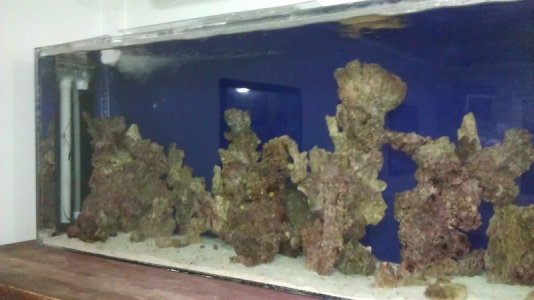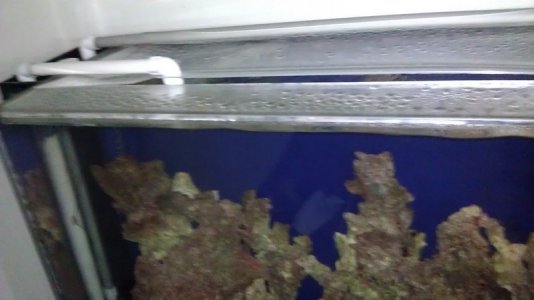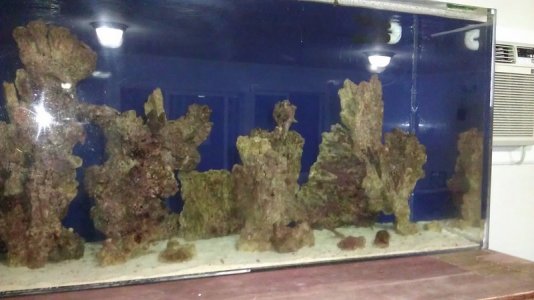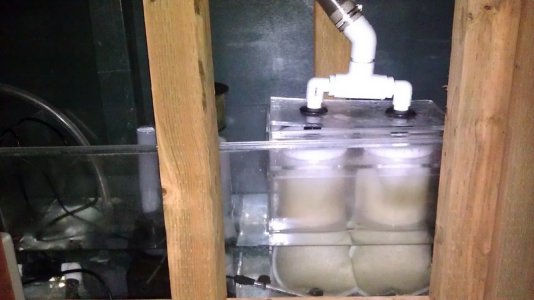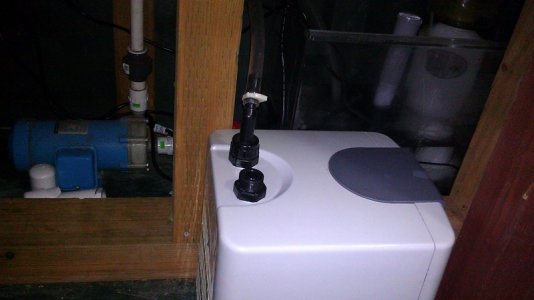Brannon132
New member
Moderators if I posted this in the wrong place please move it for me... 
So we inherited a Fish Tank! It's awesome I've always wanted a saltwater tank!!! It is 8'wide by 28" tall by 22" deep, made of 1" acrylic. There are 2 pipes coming up into the tank to feed the water in. It has a big black overflow box on the side with quarter shaped holes that cascade water from the tank to that box. There's a big hole in the bottom of that box that drains it into a tank in the bottom of the stand. From there the water goes into 2 filter socks, then there' a heater (Aquaheat, Ecoplus 300w) a skimmer (BubbleMax, PS2500) and a pump (GenX, PDX-150 35gpm) to push the water back up, and it also has a 1/10th hp chiller (Pacific Coast Imports CL280).
Originally it had a 7 inch dory (blue hippo?) a 5" yellow wrasse and a 5" brown with white spots goby? A small blue fish with a yellow tail and a large (18" dia) green starfish (brittle green?), large banded coral shrimp (5") and one red legged hermit crab. It also has about 300lbs of live rock with about 2 inches of sand in the bottom.
The tank had not been touched in over a year other than a relative putting tap water in it when the water got low and feeding the fish 2 squares of brine shrimp once a day. There was green and red algae everywhere and about an inch of salt on the top of the tank (no cover).
So here's what we did"¦ I took the water to the fish store and they said I had no Ammonia but my phosphates were through the roof. I told them I was going to move the fish tank to my office and they suggested I do a %100 water change at that time. So I drained the water from the tank into a large tub until there was about a foot of water left, then took the rock out and put it in the tub, caught the fish took them to the fish store.
When I took out the sand and asked the fish guy if I should clean the sand he said yes so I got three 5 gallon buckets full of RO water. Took all the sand out of the tank and rubbed the sand though my hands in one of the 5 gallon buckets scooped out the sand with a fish net and did it again in the second bucket then again in the third. So I basically triple filtered the sand and got a ton of the silt out of the sand. Was this the right or wrong way to do this?
After we cleaned the tank, we then went to the fish store, bought 250 gallons of saltwater and filled the tank half way. Then we put 1"of the sand back in and arranged the rock in the tank (rocks look way better now ). After that, we filled up the rest of the tank and turned on the pump and skimmer (after I already cleaned about two inches of solid brown stuff off of it"¦. Nasty).
). After that, we filled up the rest of the tank and turned on the pump and skimmer (after I already cleaned about two inches of solid brown stuff off of it"¦. Nasty).
Then we let the tank run for a few days. I went to the fish store with a water sample and they told us to add "œmicrobacter7" (good bacteria?) "œPrime" by seachem (to remove ammonia) and "œThrive" phosphate remover. They also told us to add our green starfish, brown goby and red hermit crab back into the tank while also selling us 3-4 turbo snails, 4 butterscotches, 15 small snails, and 10 hermit crabs. (do we need more snails and if so how many and of what?)
We put those in the tank and waited for a few days. Everything looked good, so we went back to the fish store where he said we still had phosphates but no ammonia or nitrates. So we got 2 sand sifting starfish (2" in dia) 2 cleaner shrimp (3"), 2 fire shrimp, along with our blue hippo. We then found out our yellow wrasse didn't make it so we got a new one, and bought two clown fish as well. I took them back in their bags and put the bags in the tank to let the water acclimate then added 3-4 ounces of water to the bag every 5-10 minutes till we doubled the water then took the fish out of the bags and put them in the water (is this the correct way to add fish?). We also got a thermometer and a refractometer(?) and changed the filter socks.
The yellow wrasse hid in the sand the blue hippo hid in the rocks and the clown fish swam around like nothing happened. We woke up in the morning and everyone was swimming around (very pretty) but no clown fish, My wife and I looked around everywhere for them and finally found them in the filter socks"¦ dead "¦. so I went to Ace hardware and got plastic gutter shield and zip tied it to where the holes were and also I made a dorso drain(?) and got a larger drain pipe so that I could turn the pump all the way on.
"¦. so I went to Ace hardware and got plastic gutter shield and zip tied it to where the holes were and also I made a dorso drain(?) and got a larger drain pipe so that I could turn the pump all the way on.
Also I noticed I also couldn't find the fire shrimp (still never have seen them) Then I looked at my temperature!!! It was 86.5 degrees! (a heat wave just hit the area). So I hopped on this forum and craigslist and got myself a ½ hp chiller (EcoPlus) (have not hooked it up yet).
The maintenance that I do so far is: I feed my fish about a nickel sized piece of fish food (special stuff made by the fish guy) twice a day (too much or too little?). I have 2 half blue half white led 120w lights and have the white on for 5 hours and the blue on for 7 (whats the max time you guys would suggest?). I also add RO water from the fish store (about 5 gallons a week!!).
I noticed that stuff is starting to grow on the rocks!!! (I think this is good?) Our goal is to have an easy-to-keep, low maintenance, harmonious and pretty tank with some corals and anemones as well as some peaceful beautiful fishies.
I bought a seachem marine basic and reef special test kit from Amazon
Here are my levels I Tested: (what else do I need to test for??)
Temp- Now (82.2)
Salinity- 1.023
PH- 8.4
Alk- 3.5
Nitrite "“ 0.0
Nitrate "“ 1.5
Free Ammonia "“ 0.0
Total Ammonia "“ 0.2
Phosphates "“ 0.8
Silicate "“ 0.1
Iodine - .02
So here are a few of my many questions:::
First off, how many things did I do wrong? What would you have done differently?
Are my pipes that are adding water in the right place and facing the right way? The left one pushes the water straight back and the right one pushes water to the left. Does it matter how the water circulates in the tank? Can I hook my chiller up to one of the pipes pushing water back up to the tank? And if so does it matter which pipe?
What other equipment do i need or should I have?
I also noticed that my starfish was attacking my sand-sifting starfish and am wondering if you would keep this guy in your tank? Is the bastard killing stuff in my tank? (like my two fire shrimp?).
What pretty & harmonious fish that are easy to moderate keepers that would you suggest putting together in my tank?
Thanks so much for your help in advance, its nice to learn from other people who you can trust and have the experiances....
Thanks, Brannon
So we inherited a Fish Tank! It's awesome I've always wanted a saltwater tank!!! It is 8'wide by 28" tall by 22" deep, made of 1" acrylic. There are 2 pipes coming up into the tank to feed the water in. It has a big black overflow box on the side with quarter shaped holes that cascade water from the tank to that box. There's a big hole in the bottom of that box that drains it into a tank in the bottom of the stand. From there the water goes into 2 filter socks, then there' a heater (Aquaheat, Ecoplus 300w) a skimmer (BubbleMax, PS2500) and a pump (GenX, PDX-150 35gpm) to push the water back up, and it also has a 1/10th hp chiller (Pacific Coast Imports CL280).
Originally it had a 7 inch dory (blue hippo?) a 5" yellow wrasse and a 5" brown with white spots goby? A small blue fish with a yellow tail and a large (18" dia) green starfish (brittle green?), large banded coral shrimp (5") and one red legged hermit crab. It also has about 300lbs of live rock with about 2 inches of sand in the bottom.
The tank had not been touched in over a year other than a relative putting tap water in it when the water got low and feeding the fish 2 squares of brine shrimp once a day. There was green and red algae everywhere and about an inch of salt on the top of the tank (no cover).
So here's what we did"¦ I took the water to the fish store and they said I had no Ammonia but my phosphates were through the roof. I told them I was going to move the fish tank to my office and they suggested I do a %100 water change at that time. So I drained the water from the tank into a large tub until there was about a foot of water left, then took the rock out and put it in the tub, caught the fish took them to the fish store.
When I took out the sand and asked the fish guy if I should clean the sand he said yes so I got three 5 gallon buckets full of RO water. Took all the sand out of the tank and rubbed the sand though my hands in one of the 5 gallon buckets scooped out the sand with a fish net and did it again in the second bucket then again in the third. So I basically triple filtered the sand and got a ton of the silt out of the sand. Was this the right or wrong way to do this?
After we cleaned the tank, we then went to the fish store, bought 250 gallons of saltwater and filled the tank half way. Then we put 1"of the sand back in and arranged the rock in the tank (rocks look way better now
Then we let the tank run for a few days. I went to the fish store with a water sample and they told us to add "œmicrobacter7" (good bacteria?) "œPrime" by seachem (to remove ammonia) and "œThrive" phosphate remover. They also told us to add our green starfish, brown goby and red hermit crab back into the tank while also selling us 3-4 turbo snails, 4 butterscotches, 15 small snails, and 10 hermit crabs. (do we need more snails and if so how many and of what?)
We put those in the tank and waited for a few days. Everything looked good, so we went back to the fish store where he said we still had phosphates but no ammonia or nitrates. So we got 2 sand sifting starfish (2" in dia) 2 cleaner shrimp (3"), 2 fire shrimp, along with our blue hippo. We then found out our yellow wrasse didn't make it so we got a new one, and bought two clown fish as well. I took them back in their bags and put the bags in the tank to let the water acclimate then added 3-4 ounces of water to the bag every 5-10 minutes till we doubled the water then took the fish out of the bags and put them in the water (is this the correct way to add fish?). We also got a thermometer and a refractometer(?) and changed the filter socks.
The yellow wrasse hid in the sand the blue hippo hid in the rocks and the clown fish swam around like nothing happened. We woke up in the morning and everyone was swimming around (very pretty) but no clown fish, My wife and I looked around everywhere for them and finally found them in the filter socks"¦ dead
Also I noticed I also couldn't find the fire shrimp (still never have seen them) Then I looked at my temperature!!! It was 86.5 degrees! (a heat wave just hit the area). So I hopped on this forum and craigslist and got myself a ½ hp chiller (EcoPlus) (have not hooked it up yet).
The maintenance that I do so far is: I feed my fish about a nickel sized piece of fish food (special stuff made by the fish guy) twice a day (too much or too little?). I have 2 half blue half white led 120w lights and have the white on for 5 hours and the blue on for 7 (whats the max time you guys would suggest?). I also add RO water from the fish store (about 5 gallons a week!!).
I noticed that stuff is starting to grow on the rocks!!! (I think this is good?) Our goal is to have an easy-to-keep, low maintenance, harmonious and pretty tank with some corals and anemones as well as some peaceful beautiful fishies.
I bought a seachem marine basic and reef special test kit from Amazon
Here are my levels I Tested: (what else do I need to test for??)
Temp- Now (82.2)
Salinity- 1.023
PH- 8.4
Alk- 3.5
Nitrite "“ 0.0
Nitrate "“ 1.5
Free Ammonia "“ 0.0
Total Ammonia "“ 0.2
Phosphates "“ 0.8
Silicate "“ 0.1
Iodine - .02
So here are a few of my many questions:::
First off, how many things did I do wrong? What would you have done differently?
Are my pipes that are adding water in the right place and facing the right way? The left one pushes the water straight back and the right one pushes water to the left. Does it matter how the water circulates in the tank? Can I hook my chiller up to one of the pipes pushing water back up to the tank? And if so does it matter which pipe?
What other equipment do i need or should I have?
I also noticed that my starfish was attacking my sand-sifting starfish and am wondering if you would keep this guy in your tank? Is the bastard killing stuff in my tank? (like my two fire shrimp?).
What pretty & harmonious fish that are easy to moderate keepers that would you suggest putting together in my tank?
Thanks so much for your help in advance, its nice to learn from other people who you can trust and have the experiances....
Thanks, Brannon


